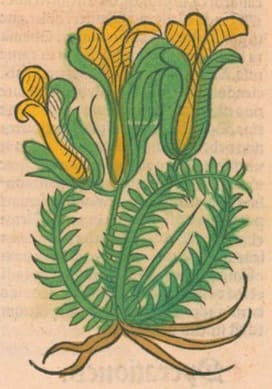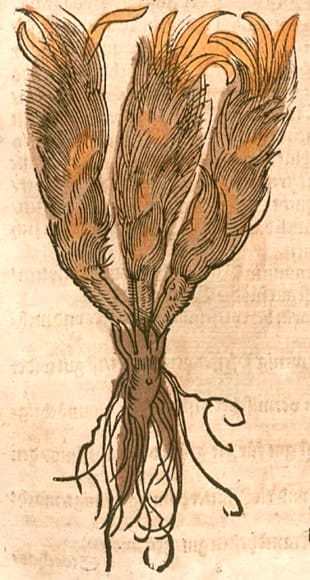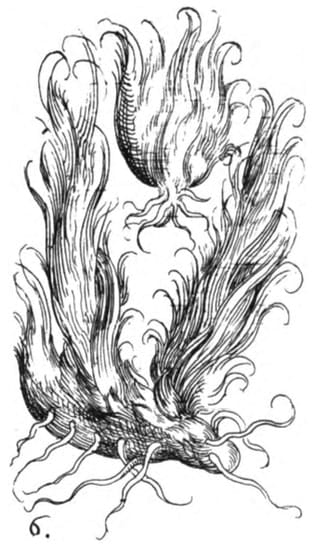Nardostachys, Indian SpikenardNardi IndicaJatamansi, Mansi (Ayurveda) Sumbul-e-Hindi, Sambul-ut-Teeb, Balchhar (Unani) Gan Song 甘松 (TCM) |

|
 Ortus Sanitatis, Meydenbach, 1491
Ortus Sanitatis, Meydenbach, 1491

|

|
|
Krauterbuch, Lonitzer, 1578 |
Krauterbuch, Danz & Uffenbach, 1610 |
 Members CLICK HERE for the PRO VERSION
Members CLICK HERE for the PRO VERSIONBotanical name:
Nardostachys jatamansi
‘there is a false Spikenard of Narbo, and a mountain Spikenard like Valerian’. (Schroder)
Parts used:
Root
Temperature & Taste:
Warm, dry. Sweet, Bitter, Aromatic
Classifications:
2A APERIENT. 2H. CARMINATIVE. 2I. ANTISPASMODIC. 2S. STRENGTHENING
3C. ALEXIPHARMIC. 3G. EMMENAGOGUE. 3J. INCREASE SEMEN
4c. CARDIAC. 4i. UTERINE. 4j. NERVINE
Uses:
1. Regulates Qi, Settles Wind, Clears Phlegm:
-Epilepsy, Hysteria, Convulsions, Palpitations, Hypertension.
-disturbed Mental state and Insomnia (API)
-regarded as rejuvenative for the Brain; “Strengthens the brain” (Avicenna)
2. Moves the Qi, opens Obstructions:
-Colic, Bloating, Gastrointestinal spasms and pain
-good for the Stomach, poor appetite, nausea; used for ‘corrosions’ of the Stomach
–Epigastric and abdominal distension with anorexia and vomiting (Chinese Pharmacopoeia)
3. Moves Qi, Regulates Menstruation:
-painful or obstructed Menstruation
-“Stops excessive Bleeding from the Uterus”. (Avicenna)
-“Useful in all kinds of Uteritis. For this purpose the patient is given a sitz bath in its decoction”. (Avicenna)
4. Clears Wind-Damp, Resists Poison:
-skin diseases including Erysipelas (API)
-Toxicity associated with Heat (Tibet)
5. Externally:
-in hair oils to stop Loss of hair and for premature greying of Hair.
-Freckles, Acne, Black spots (Ben Cao Gang Mu)
-Gargle for Toothache and Caries (Ben Cao Gang Mu, Chinese Pharmacopoeia)
-Swollen legs and feet; can be used as a wash
-externally in Lixiviums for the head and baths for the Womb
-as a collyrium applied with an eye pencil it promotes growth of eyelashes (Avicenna)
-Hemorrhoids (Ben Cao Gang Mu)
Dose:
… available in PRO version
Substitute:
… available in PRO version
Correctives:
… available in PRO version

Main Combinations:
1. Liver Obstruction and Jaundice:
i. Indian Spikenard with … available in PRO version
ii. Indian Spikenard with … available in PRO version
iii. Jaundice, Complex Fever, Chronic disease, Indian Spikenard with … available in PRO version
iv. with Liver Heat, Indian Spikenard with … available in PRO version
2. To purge Bile and Liver Heat, with … available in PRO version
3. Stomach weakness, Indian Spikenard with … available in PRO version
4. Spleen Dampness, Indian Spikenard with … available in PRO version
5. Catarrh, Indian Spikenard with … available in PRO version
6. Forgetfulness, Amnesia, Indian Spikenard with … available in PRO version
7. Urinary Incontinence, Indian Spikenard with … available in PRO version
8. Edema, Urinary obstruction:
i. Indian Spikenard with … available in PRO version
ii. Indian Spikenard with … available in PRO version
9. Cold-Damp Arthritis, Rheumatism, Back Pain, Indian Spikenard with … available in PRO version
10. Palpitations, Arrhythmias:
i. Indian Spikenard with … available in PRO version
ii. Indian Spikenard with … available in PRO version
iii. Indian Spikenard with … available in PRO version
11. Infertility from Uterus obstruction:
i. Indian Spikenard with … available in PRO version
ii. Indian Spikenard with … available in PRO version
12. Difficult Childbirth, Indian Spikenard with … available in PRO version
13. Watering Eyes, with … available in PRO version
Major Formulas
Decoction for Difficult Childbirth (Barbette)
Syrup of Wormwood
Hiera Picra
Warming Pearl Powder (Diamargariton Calidum) (Mesue)
Powder to Ascertain if Pregnant (Gabelhover)
Troches of Agrimony
Troches of Aloeswood (Trochisci Aquilaria) (Mesue)
Troches of Rose Lesser (Mesue)
Troches of Rose and Agrimony (Mesue)
Troches of Nutmeg (Rhasis)
Troches of Gallia Sebellinae (Mesue)
Troches for the Liver and Jaundice (Nicholas)
Electuary of Aloeswood (Unani)
Electuary of Saffron Lesser (Diacrocon Minus) (Mesue)
Electuary of Roman Spikenard
Electuary of Indian leaf (Zenon)
Electuary for Back Pain (Galen)
Confection for Catarrh
Antidotum Immortale
Antidotum Augustini (Nicholas)
Antidotum Epilepticus (Nicholas)
Electuarium Acharistum (Nicholas)
Electuary for Sadness and Worry
Electuary Against Forgetfulness
Electuary for Watering of the Eyes of Andrezeos
Athanasia Minor Nicholas
Athanasia Greater Nicholas
Indian Electuary Greater (Mesue)
Diacameron Minus (Nicholas)
Diacameron Magna (Diathamaron) (Nicholas)
Triphera of the Saracens (Triphera Saracenica Magna)
Foetid Pills (Mesue)
Pills of Spikenard
Pills Proven for Vision (Galen)
Pills to Clarify Pilulae Lucis Majores Mesue
Nutmeg Powder (Jatiphaladi Churna) (Ayurveda)
Cautions:
Generally Safe.
1. Caution in Qi deficiency (use with Qi tonics)
2. Use cautiously in Yin deficient Heat or Heat in the Blood.
Main Preparations used:
Oil of Spike (made by boiling in water, wine and oil), and a Compound Oil
-
Extra Info
-
History
|
‘This plant, in Sanskrit Jatamansi, has from a very remote period been in use among the Hindus as a perfume and medicine. It is mentioned by Susruta, and is prescribed by Hindu physicians as a nervine tonic and aromatic adjunct in the preparation of medicinal oils and ghritas (butters). In the Pharmacopoeia of India it is stated that Jatamansi enters into the composition of a nostrum, highly recommended in the treatment of epilepsy by Susruta. Dutt, in his Hindu Materia Medica (p. 180), says:— “I do not find in Susruta’s work any prescription for epilepsy, containing Jatamansi, except the following, in which, however, it can hardly be said to be an active ingredient. Take of the pulse of Phaseolus Roxburghii, barley, jujube fruit, seeds of Crotalaria juncea, bdellium, jatamansi root, the ten drugs collectively called dasamula, and chebulic myrobalans equal parts, and prepare a decoction in the usual manner. This decoction is recommended to be administered with the addition of clarified butter and goat’s urine. Arabic and Persian writers describe Jatamansi under the name of Sumbul aud Sumbul-i-Hindi, the latter term being used to distinguish it from Valerian, which is sometimes called Sumbul. The author of the Makhzan-el-Adwiya says that it is the Nardin of the Greeks (Dioscorides), and compares the root to the tail of a sable. He considers it to be deobstruent and stimulant, diuretic and |
emmenagogue, and recommends it in various disorders of the digestive and respiratory organs, and as a nervine tonic in hysteria, He also notices the popular opinion that it promotes the growth and blackness of the hair. Jatamansi in doses of 45 grains is often employed as an expectorant in coughs and colds. Ainslie notices that the Vytians in Lower India prepare a fragrant and cooling liniment for the head from this drug, and also prescribe it internally as a purifier of the blood. Sir W. Jones thought that the Spikenard ointment of the ancients might have been made from N. Jatamansi. (Asiat. Res. II. p. 405, and IV., p. 109.) However this may be, there can be no doubt that Jatamansi has been used in India for a similar purpose from a very early date, and that. the principal use of the drug at the present time, is for making hair washes and ointments. Sir W. O’Shaughnessy states, as the result of his experience with Jatamansi, that it is a prefect representative for Valerian. (Bengal Disp., p. 404.) It is very desirable that further trials should be instituted with this promising drug, which can be procured, at a small cost, in almost all the bazars throughout India. Care should be taken to select good specimens for trial, as the central portion of the root is often destroyed by insects. (Vegetable Materia Medica of Western India, Dymock, 1885 |
